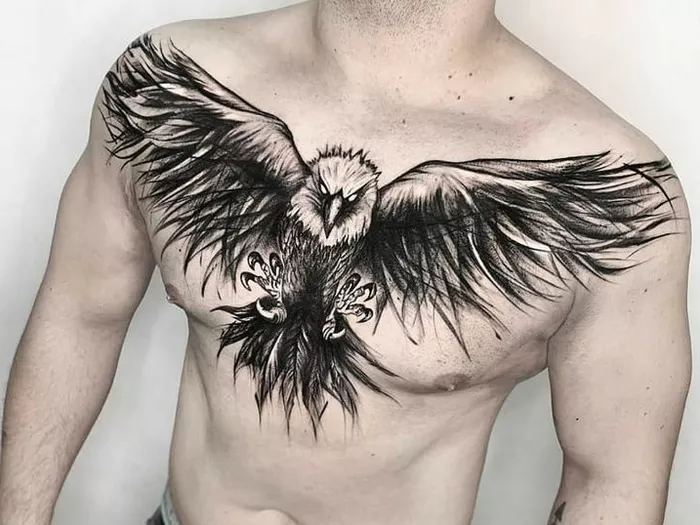Getting a tattoo on your chest can be both exhilarating and nerve-wracking. For many, the concern over pain is a significant factor in deciding whether to get inked in this sensitive area. Understanding what to expect in terms of pain levels can help you prepare mentally and physically for your tattoo experience.
Understanding Pain Perception
Pain perception varies widely among individuals due to factors such as tolerance levels, psychological preparedness, and the specific location of the tattoo. The chest is known for being a relatively sensitive area due to its proximity to bone and nerves, but the actual pain experienced can differ from person to person.
Factors Influencing Pain Levels
Several factors influence how much pain you might feel during a chest tattoo session:
1. Location on the Chest: Different parts of the chest can vary in sensitivity. The sternum (breastbone) area and near the collarbones tend to be more sensitive due to thinner skin and closer proximity to bone.
2. Individual Pain Threshold: Everyone has a different pain threshold. Factors like previous tattoo experience, general health, and mental state can affect how painful the tattoo feels.
3. Artist Technique: A skilled tattoo artist can minimize discomfort through their technique, including hand pressure, needle speed, and use of numbing agents.
4. Duration of the Session: Longer sessions can increase discomfort due to prolonged exposure to the needle.
5. Personal Health Factors: Fatigue, dehydration, and stress can heighten sensitivity to pain.
What to Expect During the Tattoo Process
When getting a chest tattoo, the process typically involves the following stages, each of which contributes to the overall experience of pain:
Preparation and Placement
Before starting, the tattoo artist will clean and shave the area to be tattooed. They will then apply a stencil of the design to ensure proper placement. This part is generally painless.
Outline
The initial outline of the tattoo is often the most uncomfortable part. The artist uses a single needle to create the outline, which involves more direct contact with the skin and can feel like a series of pinpricks or a scratching sensation. This phase sets the foundation for the tattoo and requires steady, deliberate movements from the artist.
See Also: Why is My Tattoo Warm: Things You Need To Know
Shading and Coloring
Once the outline is complete, shading and coloring are done using different types of needles and techniques. Shading may feel less intense than outlining, but areas with more detailed work or color blending can increase discomfort. The sensation during shading varies from person to person, sometimes described as a dull ache or a gentle scraping feeling.
Final Touches and Bandaging
As the tattoo nears completion, the artist will do final touch-ups and clean the area. They will then apply a bandage or protective covering to prevent infection. This stage is typically less painful as it involves minimal contact with the needle.
Coping Strategies for Pain Management
While pain is unavoidable during tattooing, there are several strategies to help manage discomfort:
Choose an Experienced Artist: A skilled tattoo artist will work efficiently and with a steady hand, minimizing unnecessary discomfort.
Mindful Breathing: Deep, steady breathing can help relax muscles and distract from pain.
Numbing Creams: Some artists offer numbing creams or sprays that can temporarily reduce sensation in the tattooed area, particularly during the more sensitive phases like outlining.
Pain Relievers: Over-the-counter pain relievers like ibuprofen can be taken before the session to reduce initial discomfort. However, it’s essential to consult with your tattoo artist and healthcare provider before taking any medication.
Take Breaks: If needed, don’t hesitate to ask for short breaks during longer sessions to stretch and relax. This can help manage fatigue and reduce overall discomfort.
Aftercare and Healing Process
Proper aftercare is crucial for minimizing pain and ensuring a successful healing process:
Follow Artist’s Instructions: Your tattoo artist will provide specific aftercare instructions, including cleaning routines and avoiding certain activities that could irritate the tattooed area.
Keep the Area Clean and Moisturized: Gentle cleansing and applying recommended ointments will aid in healing and reduce discomfort. Keeping the skin hydrated helps prevent itching and cracking as the tattoo heals.
Monitor for Infection: Watch for signs of infection such as increased pain, redness, or discharge from the tattooed area. Promptly seek medical attention if you suspect an infection.
Conclusion
Getting a chest tattoo can be a meaningful and rewarding experience, despite the temporary discomfort. Understanding the factors influencing pain levels and preparing accordingly can help you feel more confident and relaxed during your tattoo session. Remember, while pain is part of the process, it’s manageable with the right mindset, preparation, and support from a skilled tattoo artist. Embrace the journey of self-expression and enjoy your new piece of art!

